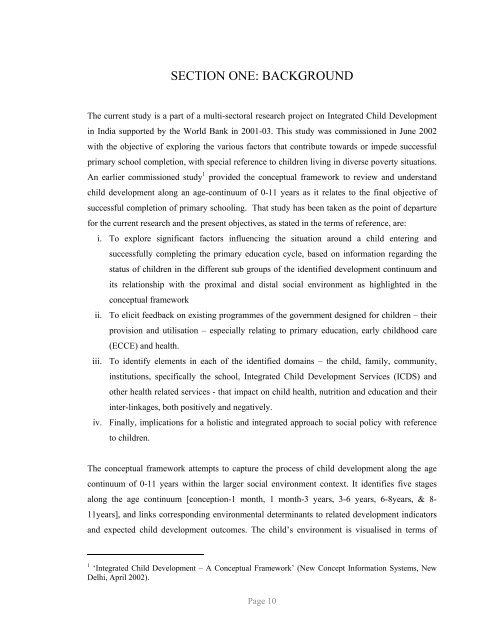Snakes and Ladders - ERU Consultants Pvt. Ltd.
Snakes and Ladders - ERU Consultants Pvt. Ltd.
Snakes and Ladders - ERU Consultants Pvt. Ltd.
Create successful ePaper yourself
Turn your PDF publications into a flip-book with our unique Google optimized e-Paper software.
SECTION ONE: BACKGROUND<br />
The current study is a part of a multi-sectoral research project on Integrated Child Development<br />
in India supported by the World Bank in 2001-03. This study was commissioned in June 2002<br />
with the objective of exploring the various factors that contribute towards or impede successful<br />
primary school completion, with special reference to children living in diverse poverty situations.<br />
An earlier commissioned study 1 provided the conceptual framework to review <strong>and</strong> underst<strong>and</strong><br />
child development along an age-continuum of 0-11 years as it relates to the final objective of<br />
successful completion of primary schooling. That study has been taken as the point of departure<br />
for the current research <strong>and</strong> the present objectives, as stated in the terms of reference, are:<br />
i. To explore significant factors influencing the situation around a child entering <strong>and</strong><br />
successfully completing the primary education cycle, based on information regarding the<br />
status of children in the different sub groups of the identified development continuum <strong>and</strong><br />
its relationship with the proximal <strong>and</strong> distal social environment as highlighted in the<br />
conceptual framework<br />
ii. To elicit feedback on existing programmes of the government designed for children – their<br />
provision <strong>and</strong> utilisation – especially relating to primary education, early childhood care<br />
(ECCE) <strong>and</strong> health.<br />
iii. To identify elements in each of the identified domains – the child, family, community,<br />
institutions, specifically the school, Integrated Child Development Services (ICDS) <strong>and</strong><br />
other health related services - that impact on child health, nutrition <strong>and</strong> education <strong>and</strong> their<br />
inter-linkages, both positively <strong>and</strong> negatively.<br />
iv. Finally, implications for a holistic <strong>and</strong> integrated approach to social policy with reference<br />
to children.<br />
The conceptual framework attempts to capture the process of child development along the age<br />
continuum of 0-11 years within the larger social environment context. It identifies five stages<br />
along the age continuum [conception-1 month, 1 month-3 years, 3-6 years, 6-8years, & 8-<br />
11years], <strong>and</strong> links corresponding environmental determinants to related development indicators<br />
<strong>and</strong> expected child development outcomes. The child’s environment is visualised in terms of<br />
1 ‘Integrated Child Development – A Conceptual Framework’ (New Concept Information Systems, New<br />
Delhi, April 2002).<br />
Page 10












